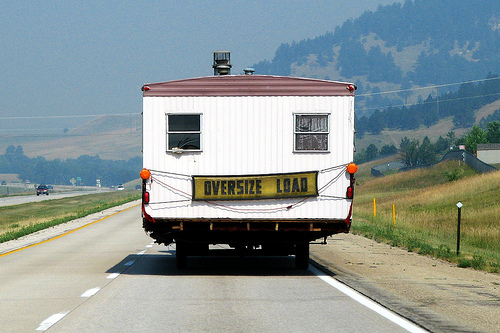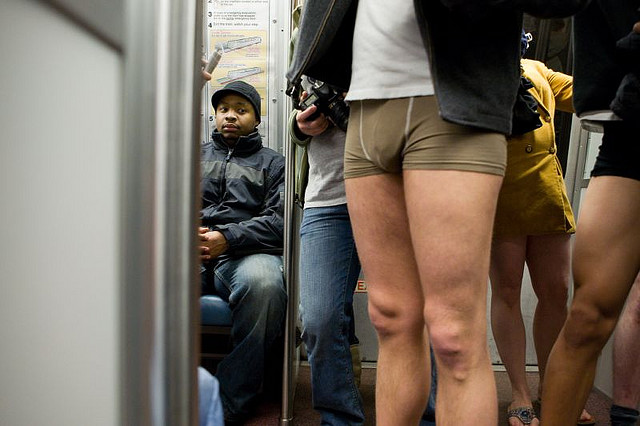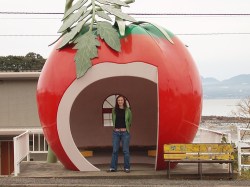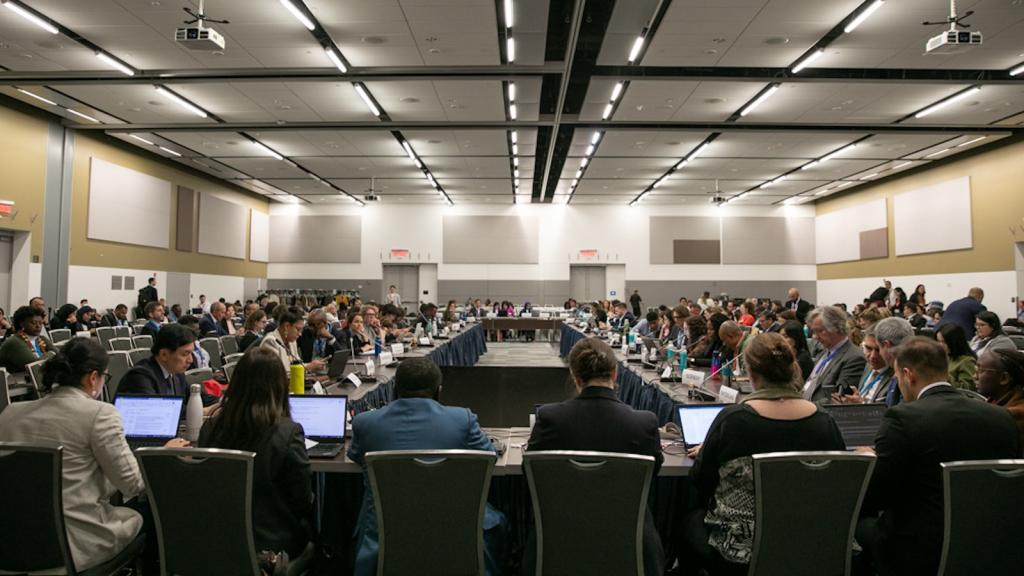
Happy No-Pants Day! (Photo by James Calder.)
When it comes to transit, even the best of us have a bad attitude. In my own case, I ride the commuter train because it’s the lesser of evils: Driving to work sucks, and the train sucks a bit less. Among those with stronger environmental devotions, transit can be an obligation: We ride the bus or train because it’s the right thing to do, not because we enjoy it.
It doesn’t have to be that way, argues urban planner Darrin Nordahl. His potent new e-book, Making Transit Fun!, has all the enthusiasm for buses, trains, and bike lanes that its title’s exclamation point implies. Can transit incorporate art? Yes! How about playground equipment? You bet. Even … sex? Oh yeah, baby.
The automobile industry has employed the best designers and marketers (and even Posh Spice) to make driving cars cool, sexy, exhilarating — and piss on transit options like biking. “Here is where we transit advocates need to take a lesson from Corporate America,” Nordahl writes. “You cannot get sufficient numbers of people to buy a product or service if it doesn’t excite them.”
 So dig this: In Holland and Berlin, train passengers can whoosh down slides — dubbed the “transfer accelerator” in Holland — to get to their trains faster. (Here’s a great video.) Bus-stop shelters in Japan are shaped like giant fruits. (No need to wait for the official fun-meisters — DIYers have outfitted bus stops with swings and periscopes!) And a marketing campaign in Copenhagen enticed motorists to ride the “love seats” on the city buses, where they might get lucky (the PG version).
So dig this: In Holland and Berlin, train passengers can whoosh down slides — dubbed the “transfer accelerator” in Holland — to get to their trains faster. (Here’s a great video.) Bus-stop shelters in Japan are shaped like giant fruits. (No need to wait for the official fun-meisters — DIYers have outfitted bus stops with swings and periscopes!) And a marketing campaign in Copenhagen enticed motorists to ride the “love seats” on the city buses, where they might get lucky (the PG version).
“The common denominator in each of these strategies is a single, positive emotion: joy,” Nordahl writes. “Joy helps transit compete against the allure of the automobile.”
Of course, if transit is mismanaged, unsafe, or ineffective — if it doesn’t go where (or when) people need it to go — no amount of joy will make it popular. But if those basics are in place, why couldn’t the best architects, designers, and artists come up with transit options that thrill us, or transit activities that entertain us?
I had two such experiences last September in that bastion of eco-tourism of Portland, Ore. The first was a ride on the aerial tram that runs from the Willamette River to the mountaintop campus of the Oregon Health & Science University. The tram, opened in 2006, cost the city a jaw-dropping $57 million to build, but it was an inspiring ride, with incredible views and lots of passengers who would normally clog traffic on the winding roads up the hill.
The second was a far less expensive, more grassroots project: The Streetcar Mobile Music Fest, an attempt to get people excited about transit by getting various bands and singers to perform on Portland’s streetcars. The idea, borrowed from Seattle, was to make the train a more vibrant experience — not just a way to get around. Singer-songwriter Sara Jackson-Holman boarded my train with a little pink piano and sang longing, haunting songs to us. This video captures the project quite beautifully:
That’s exactly what Nordahl is talking about. Why can’t a city bus look sleek, like a Studebaker? Why can’t the riders look through windows at the sky? Both feats have been accomplished in a blaze-orange bus, complete with skylights, that runs through the Quad Cities of Iowa and Illinois. Other cities, like Boulder, Colo., have spiced up their buses with splashy colors and XM radio.

By TM Weddle.
Nordahl takes on each of the transit alternatives — trains, buses, bikes, walking — and points out where they could be improved. He offers renderings that re-envision vacant alleys as pleasant, patio-lined walkways. To encourage and enliven biking, he points to various playful designs for bike racks — like David Byrne’s racks in New York City in the shape of a dog, a busty woman, and, on Wall Street, a dollar sign.
In an era of austerity, people might ask whether we can afford high design. Nordahl takes on the question directly: With planning, more designed and aesthetically pleasing options need not cost more — and has great potential payoff. In Portland, a $60-million investment in bike infrastructure — the cost of building one mile of urban highway — has made the city a leading biking destination, which has helped its image as a green, sophisticated, livable town.
And finally, one also has to consider the cost of transit that isn’t used because it sucks. Cities and states pour billions into transit options. With that kind of money, you’d think we would want to make it worth the ride.




